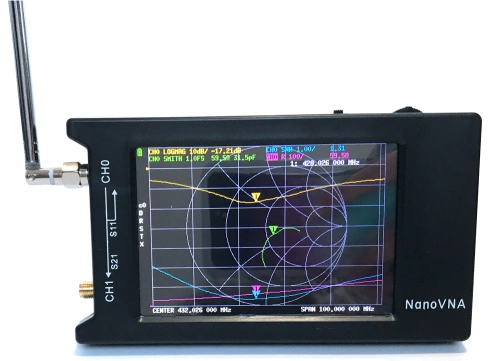This is the first in a series of articles on the NanoVNA. As more articles are posted, the links at the bottom of this article will be updated.
Before discussing the NanoVNA and why a ham might want one, what a “VNA” or a vector network analyzer is needs to be discussed. A VNA is a measurement instrument that measures the response of a network of electronics either through its reflection measurements (e.g. SWR, Smith Chart plots, etc.) or through measurements (e.g. detected power, etc.). A VNA is particularly valuable because it plots information against two axis, such as SWR across a frequency range or power observed passing though something connected to both ports. A VNA can be used similar to an antenna analyzer to measure antenna efficiency but also to test the power of a (low powered) device such as a signal preamp or check the power-passing/rejecting of a filter. It does this by having one port that emits a set of signals across a frequency range and that can monitors reflections back to it. The second port can monitor forward activity such as power, magnitude, phase, etc.

Traditionally, a VNA was a $10,000+ instrument available to only professional radio/RF engineers. However, in 2017 a Japanese ham going by “edy555” released an open source project that constructed features of a VNA on top of an STM microcontroller based on some earlier work done by a group of hams in Texas on an SDR. From that work, a Chinese ham named Gen Hu (“hugen”) created a fully assembled system and offered it for sale. Based on that work, edy555, hugen, and others have continued to refine both the software and guide additional hardware development. The result today in 2021 is the NanoVNA-H and the NanoVNA-H4 that are at the forefront of the NanoVNA product line.
While there are a number of “NanoVNA” devices, the community behind the system generally supports the mainline NanoVNA-H4 as the product of choice. The H4 is available from Gigaparts and R&L Electronics.
Beyond just the hardware device itself, there is software available to hook a NanoVNA into a computer to perform a variety of tasks. There are also a number of various “threads” of firmware available for the NanoVNA that change or improve the device depending on a user’s needs.
Future articles will dive into choosing a firmware and then using the device for a variety of tasks.
All Articles in the NanoVNA Series:
Part 1 – NanoVNA: What Is It?
Part 2 – NanoVNA: Devices & Firmware
